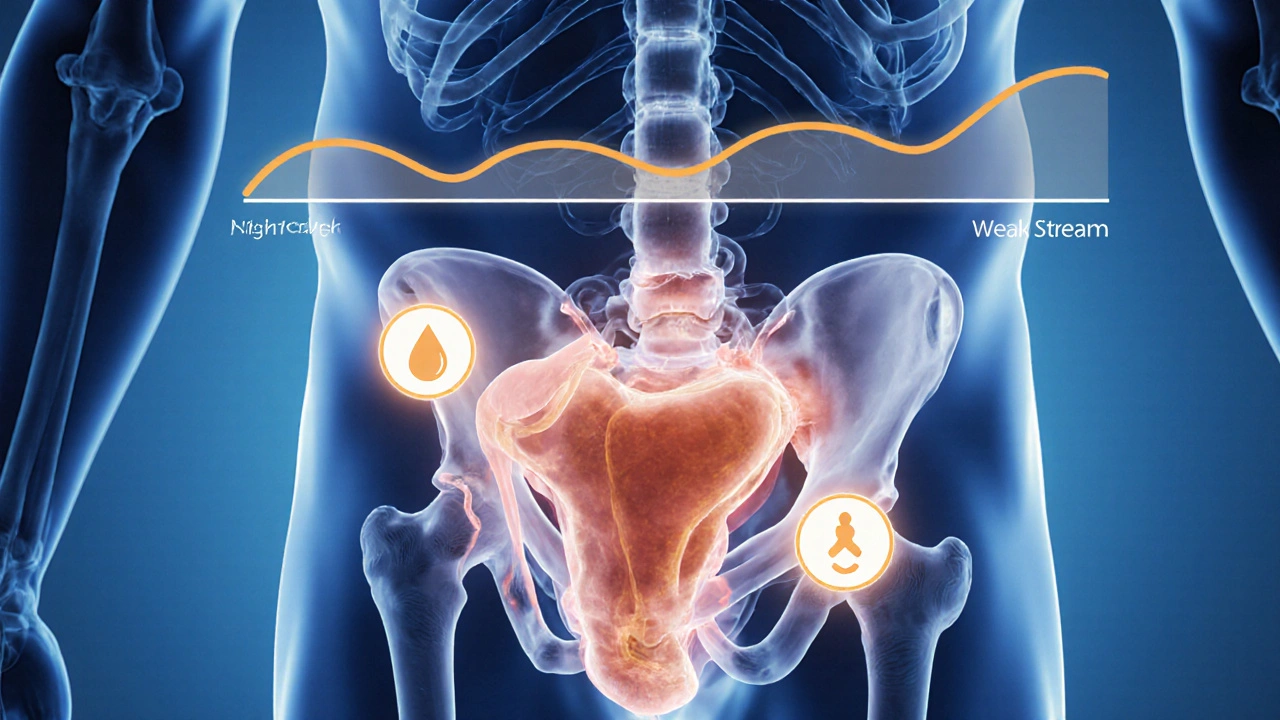Benign Prostatic Hyperplasia: Symptoms, Treatments, and Medication Insights
When your prostate grows larger but isn’t cancerous, you’re dealing with benign prostatic hyperplasia, a common, non-cancerous enlargement of the prostate gland that affects most men over 50. Also known as BPH, it’s not life-threatening, but it can make everyday life frustrating—especially when you’re constantly rushing to the bathroom or waking up at night to urinate. This isn’t just about aging. It’s about how the prostate presses on the urethra, blocking urine flow and triggering a chain reaction of symptoms that many men ignore until they become unbearable.
Men with benign prostatic hyperplasia, a common, non-cancerous enlargement of the prostate gland that affects most men over 50. Also known as BPH, it’s not life-threatening, but it can make everyday life frustrating—especially when you’re constantly rushing to the bathroom or waking up at night to urinate. This isn’t just about aging. It’s about how the prostate presses on the urethra, blocking urine flow and triggering a chain reaction of symptoms that many men ignore until they become unbearable.
Many of the posts here focus on how medications interact with conditions like BPH. For example, some drugs for depression, high blood pressure, or even common colds can make urinary symptoms worse. Ramipril, an ACE inhibitor used to treat high blood pressure, and diclofenac gel, a topical NSAID for pain relief, don’t directly target the prostate, but they’re part of the bigger picture—because men with BPH often take multiple meds, and interactions matter. Even caffeine, found in coffee and energy drinks, can irritate the bladder and worsen nighttime urination, as shown in posts about caffeine and medications, how common stimulants interfere with drug effectiveness and worsen urinary symptoms.
What you’ll find in this collection isn’t just theory. It’s real-world advice from men who’ve been there. You’ll see how drugs like vardenafil (Levitra) and sildenafil (Viagra)—often used for erectile dysfunction—also affect urinary flow. Some men don’t realize these ED meds can actually help with BPH symptoms by relaxing smooth muscle in the prostate and bladder neck. Others are confused why their diuretic for swelling, like indapamide, a thiazide-like diuretic used to reduce fluid retention and lower blood pressure, makes their nighttime trips worse. And yes, timing matters: taking calcium with bisphosphonates for bone health? That’s a known clash. So is mixing certain antibiotics with prostate meds.
This isn’t about scare tactics or quick fixes. It’s about understanding how your body works, what your meds are really doing, and how to avoid common traps that make BPH harder to manage. You’ll find clear comparisons between treatments, tips on avoiding drug interactions, and real strategies that help men stay in control—without surgery or extreme lifestyle changes. Whether you’re just noticing symptoms or have been living with them for years, the guides here give you the facts you need to talk smarter with your doctor and make better choices every day.

How Testosterone Levels Influence BPH Symptoms: What Men Need to Know
- Oct, 12 2025
- 6
Explore how testosterone levels affect BPH symptoms, learn to interpret hormone tests, and discover treatment and lifestyle tips for better prostate health.
Categories
- Health and Wellness (51)
- Medicine (36)
- Health and Medicine (23)
- Women's Health (9)
- Mental Health (8)
- Men's Health (7)
- Beauty and Wellness (4)
- Health Information (4)
Archives
- December 2025 (12)
- November 2025 (25)
- October 2025 (27)
- September 2025 (14)
- August 2025 (3)
- July 2025 (2)
- June 2025 (2)
- May 2025 (3)
- April 2025 (4)
- March 2025 (4)
- February 2025 (2)
- January 2025 (3)
- online pharmacy
- medication safety
- dietary supplement
- health benefits
- dietary supplements
- prevention
- fertility
- online pharmacy Australia
- treatment
- treatment options
- benefits
- connection
- drug interaction
- drug interactions
- pregnancy
- Cancer Treatment
- depression medication
- antidepressants
- quality of life
- anxiety treatment
